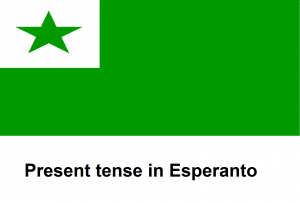Language/Esperanto/Grammar/Present-Tense
Jump to navigation
Jump to search
Rate this lesson:
Hello everybody,
In today's lesson you will learn some useful vocabulary about ¨PRESENT TENSE¨ in Esperanto.
Feel free to edit this page by adding new words and expressions !
Happy learning ! :)
When you've grasped the concepts in this module, you may want to check out these connected subjects: Gender, Negation, COMPARATIVES & Word Order.
Some explanation for Present tense in Esperanto[edit | edit source]
OBS.: In the infinitive form; change the last letter (-i) by (-as) to form the Present Tense
| ENGLISH | PRONUNCIATION
ENGLISH |
ESPERANTO | PRONUNCIATION
BRAZILIAN PORTUGUESE |
BRAZILIAN
PORTUGUESE |
|---|---|---|---|---|
| to have | hah vih | havi | ter | |
| I have | mih hah vahs | Mi havas | mi Ha vas | Eu tenho |
| You have | vih hah vahs | Vi havas | vi Ha vas | Você tem |
| He has | lih hah vahs | Li havas | li Ha vas | Ele tem |
| She has | shih hah vahs | Ŝi havas | chi Ha vas | Ela tem |
| We have | nih hah vahs | Ni havas | ni Ha vas | Nós temos |
| You have | vih hah vahs | Vi havas | vi Ha vas | Vocês tem |
| They have | ih lih hah vahs | Ili havas | ili Ha vas | Eles tem |
| I come | mih veh nahs | Mi venas | mi ve nas | Eu venho |
| I eat an egg | mih mahn jahs oh vohn | Mi manĝas ovon | mi man djas o von | Eu como um ovo |
In Esperanto, expressing present tense is changing the "-i" of a verb to "-as".[edit | edit source]
- I come. - Mi venas.
- I eat an egg - Mi manĝas ovon.
Other Lessons[edit | edit source]
- Questions
- Comaratives and Superlatives
- Past Participle in Esperanto
- PREFIXES
- Prefixe MAL— and Suffixe —IN
- Personal pronouns
- THE PARTICIPLES
- Verbs
- THE NEGATIVE
- Conditional Mood

